Menu for Fiscal Year 2024
School Lunch on Monday, March 17, 2025
Joshu Kinpira
The local school lunch for March features Gunma Prefecture. Joshu Kinpira uses ingredients such as konnyaku and pork, which are specialties of Gunma Prefecture. Joshu is the old name for what is now Gunma Prefecture.
Gunma Prefecture has the highest production volume of konjac potatoes, the raw material for konjac, in Japan, accounting for over 95% of the national production.
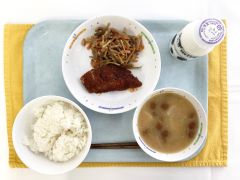
School Lunch on Wednesday, March 5, 2025
Green Pepper Steak
The world cuisine for March is China. China is a very large country, and Chinese cuisine is divided into four types: Beijing cuisine, Shanghai cuisine, Cantonese cuisine, and Sichuan cuisine.
Chinjaorosu is a type of Sichuan cuisine. The word "Chinjao" means "green pepper," "ro" means "meat," and "su" means "shredded," referring to a dish stir-fried with shredded green peppers and meat. In school lunches, shredded pork, bamboo shoots, and green peppers are stir-fried and seasoned with oyster sauce and other ingredients.

School lunch on February 19, 2025 (Wednesday)
Kenchin Soup
The local school lunch for February is from Kanagawa Prefecture. It is said that Kenchin-jiru, which was made at Kencho-ji Temple in Kamakura City, Kanagawa Prefecture, came to be called Kenchin-jiru.
Kenchin soup is a type of "shojin ryori" (Buddhist vegetarian cuisine) eaten by monks, made without meat and using plant-based ingredients such as vegetables and soybeans. It allows you to savor the flavors of the vegetables.

School lunch on February 14, 2025 (Friday)
Irish Stew
The world cuisine for February is Ireland. Ireland is an island nation located on the west side of Britain, often referred to as the Emerald Isle, a country rich in greenery and nature.
Irish stew is a traditional dish from Ireland. It is a stew made with meat and potatoes, and there are various recipes depending on the household. In Ireland, it is often made with lamb, but in school lunches, it was made with pork.
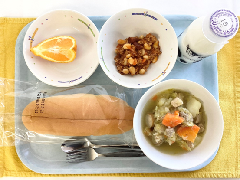
School lunch on January 30, 2025 (Thursday)
Putin
The world cuisine for January is Canada. Canada is surrounded by rich nature and has many people who have moved from various countries, coexisting with diverse ethnicities and cultures.
Poutine is a dish that originated in Canada, consisting of french fries topped with gravy (a sauce made from meat juices) and cheese. In school lunches, butter was added to the sauce instead of cheese and poured over the french fries.

School lunch on January 17, 2025 (Friday)
Salt Zangi
The local school lunch in January is from Hokkaido. In Hokkaido, fried chicken is called "Zangi." It is said that "Zangi" originated from a chicken restaurant in Kushiro City, Hokkaido, where chicken was cut into large pieces and then fried.
The origin of the name "Zangi" is said to have come from the Chinese dish "Zagi," which is fried chicken, with the addition of the character "n" in between to bring good luck, resulting in "Zangi." In school lunches, chicken was seasoned with salt, garlic, and ginger before being fried.

School lunch on December 18, 2024 (Wednesday)
Noppe
The local school lunch for December is from Niigata Prefecture. "Noppe" is a traditional New Year's dish in Niigata Prefecture, but it is a home-cooked meal that can be enjoyed year-round. It is also made in various households during festivals and celebrations.
The essential ingredient for noppe is taro. A lot of taro is used, and the dish is finished with a slightly thickened broth. The method of preparation varies by household, but it can also include snow peas or salted salmon roe called "totomame" sprinkled on top. Taro is also used in the school lunch version of noppe.
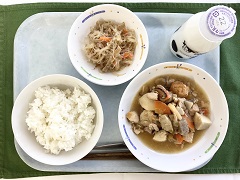
School lunch on December 6, 2024 (Friday)
Sopa de Ajo
The world cuisine for December is Spain. Olive oil, an essential ingredient in Spanish cuisine. Spain is the country with the highest production of olive oil in the world due to its terrain and climate suitable for olive production.
"Sopa de Ajo" is a garlic soup from Spain. "Sopa" means "soup" in Spanish, and "ajo" refers to garlic. In the school lunch, we made the soup by sautéing garlic in olive oil.

School lunch on November 22, 2024 (Friday)
Sweet Potato Stew
The local school lunch in November features Yamagata Prefecture. Imoni is a type of hot pot dish made with taro, commonly eaten in the Tohoku region during the autumn to winter harvest season. Taro has been a staple ingredient in Japan for a long time.
Imoni, or taro stew, has different ingredients depending on the region, in addition to taro. The seasoning also varies, with options like miso and soy sauce. The school lunch version of imoni includes ingredients like pork and is seasoned with soy sauce.
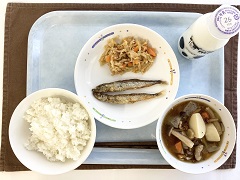
School lunch on November 19, 2024 (Tuesday)
Hoki Fry
The world cuisine for November is New Zealand. New Zealand is a long island nation like Japan, with four seasons. Surrounded by the sea, there is a culture of eating seafood.
In the school lunch, we made hoki fry using hoki fish from New Zealand. Hoki is a type of white fish, similar to cod. It has a mild flavor and a soft texture, making it a common ingredient for frying and other dishes.
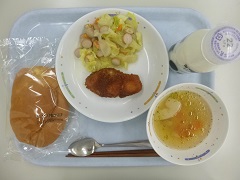
School lunch on Tuesday, October 29, 2024
Basil Chicken Rice
The world cuisine for October is Thai. Thailand is located in Southeast Asia and is officially called the "Kingdom of Thailand."
The term 'Gapao' in Gapao rice means 'basil' in Thai.
In Thai cuisine, a variety of herbs are often used, along with a seasoning called "nam pla." Nam pla is a seasoning made from fermented fish, characterized by its unique aroma and strong umami flavor.
The school lunch's gapao rice was seasoned using fish sauce.
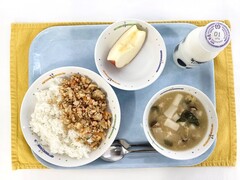
School lunch on October 28, 2024 (Monday)
Satsuma Soup
The local school lunch for October is from Kagoshima Prefecture. Satsuma-jiru is a regional dish that has been eaten in Kagoshima since the Edo period, and "Satsuma" is an old name for Kagoshima Prefecture.
Satsuma soup is characterized by the inclusion of chicken, and it is often eaten when guests come over or during celebrations.
In addition, the sweet potato soup served in the school lunch contains sweet potatoes that are harvested in large quantities in Kagoshima Prefecture. The name of the sweet potato also comes from the old name of Kagoshima Prefecture, "Satsuma."

School lunch on Thursday, September 12, 2024
Source Katsu
Sosukatsu-don is a local gourmet dish from Fukui Prefecture, consisting of crispy fried cutlet coated in sauce and served over rice.
When it comes to katsudon, the standard is a pork cutlet topped with egg and served over rice, but in Fukui Prefecture, this sauce katsudon is said to be the norm.
The sauce for katsu is made by adding sweetness and richness with sugar and mirin, based on ingredients like ketchup and Worcestershire sauce. This rich sauce enhances the umami of the katsu.
We made chicken cutlets for the school lunch and added sauce.
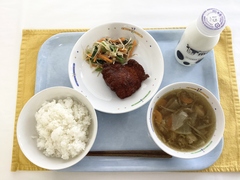
School lunch on September 4, 2024 (Wednesday)
Pittipanna
The world cuisine for September is Sweden.
Sweden is a nature-rich country located in Northern Europe, with about half of the country covered by forests.
"Pittipanna" is a Swedish home-cooked dish, which means "small things in a frying pan" in Swedish. It is made by sautéing finely chopped potatoes, onions, and sausage.
Potatoes are a staple food that is widely consumed in Sweden and are an essential ingredient in traditional Swedish cuisine. It is said that Pitepanna originated from the need to use up leftover potatoes.
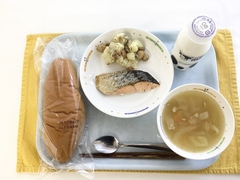
School lunch on July 16, 2024 (Tuesday)
Mozuku Soup
The local school lunch for July is from Okinawa Prefecture.
Mozuku, used in mozuku soup, is a type of seaweed, similar to wakame and hijiki. In Okinawa Prefecture, where the production of mozuku is the highest in Japan, it is sometimes eaten as tempura.
In today's school lunch, we added mozuku seaweed to a soup made with chicken broth, allowing everyone to enjoy the smooth texture and crunchiness of the mozuku.
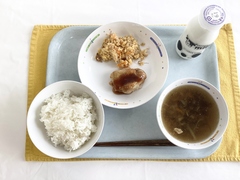
School lunch on July 10, 2024 (Wednesday)
Minestrone
The world cuisine for July is Italian. Italy is a country in southern Europe, shaped like a "boot" that juts out into the Mediterranean Sea. Like Japan, it has four seasons.
When it comes to Italian cuisine, there are many dishes that use tomatoes. Italian tomatoes become more flavorful when cooked, making them suitable for stews. Additionally, they are often longer and slimmer in appearance compared to Japanese tomatoes.
In the school lunch, we enjoyed "Minestrone," one of the Italian home-cooked dishes. "Minestrone" means "a soup with plenty of ingredients," and it was made by simmering it with a lot of vegetables.

School lunch on Thursday, June 27, 2024
Dakgalbi Bowl
The world cuisine for June is Korea, a country close to Japan.
Dak-galbi is one of the Korean grilled meat dishes, where "dak" means chicken and "galbi" means ribs. It is a dish made by stir-frying chicken and vegetables such as cabbage and onions with Korean miso and gochujang. The "cheese dak-galbi" topped with cheese is also famous.
We had "Takkarubi Don" served over rice for lunch.
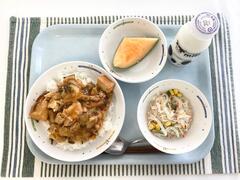
School lunch on Thursday, June 13, 2024
Hikinairi
This month's local school lunch is from Fukushima Prefecture.
Hikinairi is one of the local dishes eaten in Fukushima Prefecture. "Hikina" refers to shredded vegetables such as radish in the dialect of Fukushima Prefecture, and the dish made by stir-frying "hikina" is called "hikinairi." It is said to be a dish made from vegetables that have been shredded and preserved for the winter, and it has been cherished as a home-cooked meal since ancient times.
The ingredients and seasonings used vary by household, but in the school lunch, we used daikon, chicken, chikuwa, carrots, and bell peppers, and seasoned them sweet and savory with sugar and soy sauce.

School lunch on Wednesday, May 29, 2024
Wiener Sausage with Tomato Sauce
The world cuisine for May is Argentina.
Argentina is a country located in the southeastern part of the South American continent. Blessed with great nature such as jungles and grasslands, agriculture and livestock farming have become active. In particular, it has a food culture that consumes a lot of meat, with per capita meat consumption being among the highest in the world.
Choripan is a dish that consists of a thick sausage called chorizo sandwiched in bread. It is sometimes served with a sauce called chimichurri, made from vinegar and spices. This time, the menu features a choripan-style dish with a sausage coated in tomato sauce sandwiched in a koppepan.
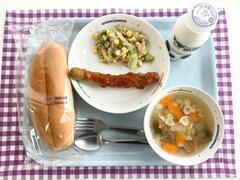

School lunch on May 27, 2024 (Monday)
Sawarashi with Saikyo Miso Sauce
The local school lunch in May is from Kyoto Prefecture.
Miso is a fermented food made by adding salt and koji to grains such as soybeans, rice, and barley, and is one of Japan's traditional seasonings. It is produced in various regions across Japan, each with its own unique ingredients, flavors, and colors, making it a food rich in regional characteristics. Saikyo miso was born in Kyoto during the Edo period and is still produced there today. It is characterized by its light color and sweetness, and is one of the types of white miso. The name "Saikyo miso" was given because, after the Meiji Restoration, Edo was renamed "Tokyo," leading to Kyoto, the western capital, being referred to as "Saikyo."
In today's school lunch, we made a sauce with Saikyo miso and poured it over grilled Spanish mackerel.
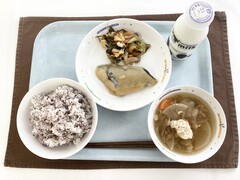
School lunch on April 30, 2024 (Tuesday)
Asuka Soup with Soy Milk
The local school lunch in April is from Nara Prefecture.
Asuka soup is a miso-based soup that contains milk, chicken, and seasonal vegetables, and it is a traditional dish from Nara Prefecture. It is said that during the Asuka period, milk and chicken dishes were brought from the Tang dynasty of China and were consumed among the nobility.
Today's school lunch Asuka soup used soy milk instead of regular milk. Both the soy milk and the miso used for seasoning are made from soybeans, so they pair well together, resulting in a rich flavor.

School lunch on April 19, 2024 (Friday)
Scotch Bross
This month's world cuisine is British.
Scotch broth is a famous dish from Scotland, UK, and is a hearty soup made by simmering meat, vegetables, barley, and more. While lamb or beef is often used in traditional recipes, pork was used in the school lunch version.
The barley used in the soup is called "pressed barley," which is made by steaming and crushing barley, then drying it. It is rich in dietary fiber that helps improve digestion, and you can enjoy its chewy texture.

Please let us know your feedback on how to make our website better.
Inquiries about this page
Inagi City Department of Education School Lunch Division
3648 Yanokuchi, Inagi City, Tokyo 206-0812
Phone number: 042-377-8904 Fax number: 042-379-1501
Contact the School Lunch Division, Department of Education, Inagi City
